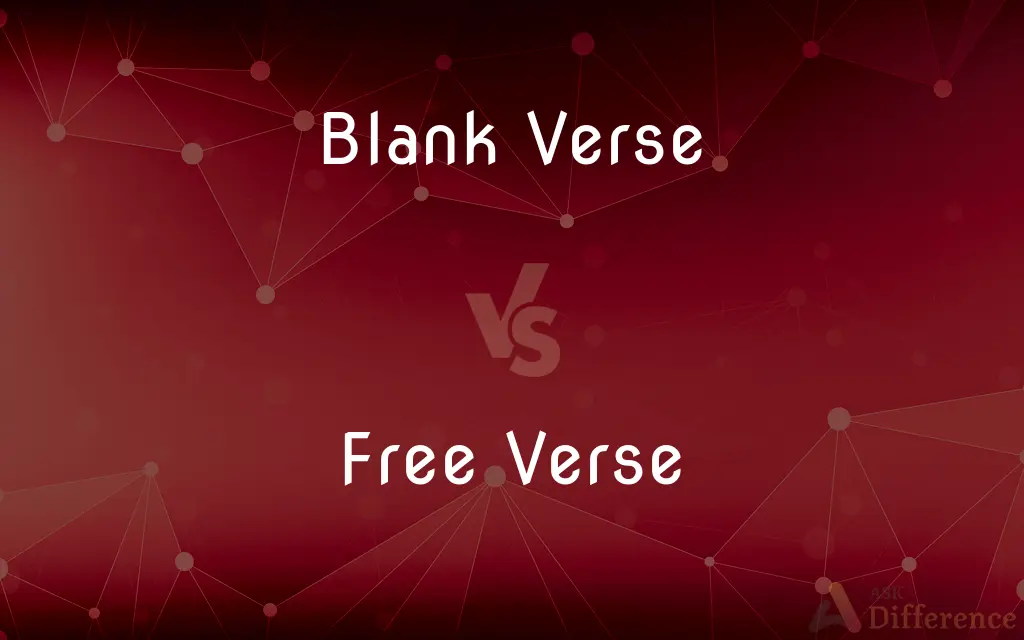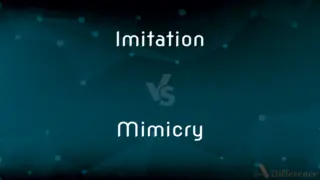Blank Verse vs. Free Verse — What's the Difference?
Edited by Tayyaba Rehman — By Fiza Rafique — Published on October 25, 2023
Blank Verse is unrhymed poetry written in iambic pentameter, while Free Verse is poetry free from consistent meter patterns, rhyme, or any other musical pattern.

Difference Between Blank Verse and Free Verse
Table of Contents
ADVERTISEMENT
Key Differences
Blank Verse and Free Verse are both forms of poetry, but they differ significantly in their structure and approach. Blank Verse is a more structured form, defined by its use of unrhymed lines written in iambic pentameter. This means that although it doesn't rhyme, it maintains a steady rhythm throughout, making it a favorite for many classical playwrights, including William Shakespeare. On the other hand, Free Verse is characterized by its lack of strict meter or rhyme. This freedom gives poets the flexibility to craft their lines as they see fit, without being confined to a particular rhythmic structure.
While Blank Verse provides a subtle rhythmic beauty, Free Verse often seeks to capture the natural rhythms of speech or the erratic contours of thoughts and emotions.
Essentially, while both forms offer poets different tools to convey meaning and emotion, Blank Verse does so within a rhythmic framework, whereas Free Verse breaks away from traditional structures to allow for more fluid expression.
Comparison Chart
Rhythmic Structure
Uses iambic pentameter.
Lacks consistent meter patterns.
Rhyme
Unrhymed.
Can be rhymed or unrhymed.
ADVERTISEMENT
Flexibility
Structured by meter.
High flexibility without meter constraints.
Usage
Often in classical plays and poems.
Modern poetry, capturing natural speech.
Representation
Subtle rhythmic beauty.
Fluid, free expression.
Compare with Definitions
Blank Verse
Often used in classical English literature.
Blank Verse gives Julius Caesar its rhythmic quality.
Free Verse
Breaks traditional poetic constraints.
Carl Sandburg's Chicago captures the city's essence in Free Verse.
Blank Verse
Maintains rhythm without needing rhyme.
Christopher Marlowe utilized Blank Verse in Doctor Faustus.
Free Verse
Mimics the natural rhythms of speech.
The Waste Land by T.S. Eliot employs Free Verse.
Blank Verse
A structured poetic form without rhyme.
Paradise Lost by John Milton is written in Blank Verse.
Free Verse
Offers poets flexibility in expression.
E.E. Cummings often wrote in a Free Verse style.
Blank Verse
Unrhymed poetry with iambic pentameter.
Much of Shakespeare's work, like Hamlet, is in Blank Verse.
Free Verse
A modernist approach to poetry.
Portrait of the Artist as a Young Man contains segments of Free Verse.
Blank Verse
A blend of formal structure and open-ended expression.
The soliloquies in Macbeth demonstrate the beauty of Blank Verse.
Free Verse
Poetry without strict rhyme or rhythm.
Walt Whitman's Leaves of Grass is a notable Free Verse collection.
Common Curiosities
Are Blank Verse and Free Verse the same since they don't rhyme?
No, Blank Verse follows iambic pentameter, while Free Verse lacks consistent meter.
Is Blank Verse popular in plays?
Yes, especially in classical plays like those by Shakespeare.
Why might a poet choose Free Verse?
For its flexibility and ability to mimic natural speech patterns.
Is Free Verse easier to write since it's free of constraints?
Not necessarily. Crafting meaningful Free Verse requires skill to convey emotion without traditional structures.
Can a poem switch between Blank Verse and Free Verse?
Yes, poets can use varied structures in a single work.
Does Blank Verse always follow iambic pentameter?
Typically, yes, that's its defining feature.
Can Free Verse contain rhyme if the poet wishes?
Yes, Free Verse can have occasional rhymes but lacks a consistent pattern.
Why did Shakespeare use Blank Verse?
It allowed rhythmic beauty without the constraints of rhyme.
Why might a poet use Blank Verse over rhymed verse?
Blank Verse offers rhythmic elegance without the need for end-line rhymes.
Which poets are famous for Free Verse?
Poets like Walt Whitman and E.E. Cummings are renowned for their Free Verse.
Which form is more modern?
Free Verse is more associated with modern poetry, while Blank Verse is more classical.
How does one identify Blank Verse in a poem?
Look for unrhymed lines with a consistent rhythmic pattern of iambic pentameter.
Do all poems written in Free Verse lack rhythm?
No, they may have rhythm, but it's not consistent like in metrical forms.
What's the main appeal of Free Verse?
Its ability to provide authentic, unrestricted expression.
Is Blank Verse common in contemporary poetry?
While not as prevalent as in the past, some modern poets still employ Blank Verse.
Share Your Discovery

Previous Comparison
Flaw vs. Defect
Next Comparison
Imitation vs. MimicryAuthor Spotlight
Written by
Fiza RafiqueFiza Rafique is a skilled content writer at AskDifference.com, where she meticulously refines and enhances written pieces. Drawing from her vast editorial expertise, Fiza ensures clarity, accuracy, and precision in every article. Passionate about language, she continually seeks to elevate the quality of content for readers worldwide.
Edited by
Tayyaba RehmanTayyaba Rehman is a distinguished writer, currently serving as a primary contributor to askdifference.com. As a researcher in semantics and etymology, Tayyaba's passion for the complexity of languages and their distinctions has found a perfect home on the platform. Tayyaba delves into the intricacies of language, distinguishing between commonly confused words and phrases, thereby providing clarity for readers worldwide.
















































